In any case, New Year's Eve has very important (added personal) significance to us. We opened a bottle of Champaign. To go with the bottle of vintaged Champaign, my opening salvo was a chawanmushi 茶碗蒸し or Japanese savory egg custard topped with California gold uni and salmon roe (ikura).
Friday, January 6, 2012
New Year's Eve: Champagne and Chawanmushi with sea urchin and salmon roe 大晦日夜 シャンパンと雲丹とイクラのせ茶碗蒸し
This was the last day of 2011. According to the old Japanese system for counting a person's age called "Kazoe-doshi" 数え年, everybody turned one year older on New year's day and New Year's Eve was referred to as "Otoshitori" お年取り meaning to be a year older. Although eating soba noodles or "toshikoshi soba" 年越しそば on New Year's Eve appears to be popular, this was not the custom in our household when I was growing up. I think eating soba noodles is more a custom for trades people who simply did not have enough time to make an elaborate dinner on New year's eve. My mother used to give us a feast for New Year's Eve akin to Christmas dinner.
In any case, New Year's Eve has very important (added personal) significance to us. We opened a bottle of Champaign. To go with the bottle of vintaged Champaign, my opening salvo was a chawanmushi 茶碗蒸し or Japanese savory egg custard topped with California gold uni and salmon roe (ikura).
My chawanmushi recipe is the same as before; three parts seasoned dashi broth and one part whole egg. To accommodate the special toppings, I did not use all the ingredients I usually use such as shiitake mushroom and shrimp. Instead I used only ginko nuts (from a can), shimeji mushroom, small pieces of chicken and sliced (on a slant) scallion. As ususal, from 3 eggs (about 150ml) plus seasoned dashi broth (450ml), I made 6 small containers (a small cup for dipping soba noodle) as you see below.
 I let it sit after steaming was completed for 10 minutes so that the chawanmushi was not too hot and topped it with the uni and ikura. This was the ultimate--perhaps only surpassable with the addition of foie gras but I have not tried that yet!. This dish went so well with this Champagne. Although we are not champagne connoisseurs by a long shot, this particular one had a pleasant yeastiness with a fruity finish that went very well with the richness of the dish.
I let it sit after steaming was completed for 10 minutes so that the chawanmushi was not too hot and topped it with the uni and ikura. This was the ultimate--perhaps only surpassable with the addition of foie gras but I have not tried that yet!. This dish went so well with this Champagne. Although we are not champagne connoisseurs by a long shot, this particular one had a pleasant yeastiness with a fruity finish that went very well with the richness of the dish.
 This was followed by a small sashimi (tuna and uni) and pickled herring in cream sauce (the white stuff in the picture above). The pickled herring was a nod to my wife's tradition of eating herring on New Year's eve. She claims this came from growing up in Pennsylvania Dutch country. She admitted, however, that the herring was too harsh a flavor compared to the subtlety of the sashimi.
This was followed by a small sashimi (tuna and uni) and pickled herring in cream sauce (the white stuff in the picture above). The pickled herring was a nod to my wife's tradition of eating herring on New Year's eve. She claims this came from growing up in Pennsylvania Dutch country. She admitted, however, that the herring was too harsh a flavor compared to the subtlety of the sashimi.
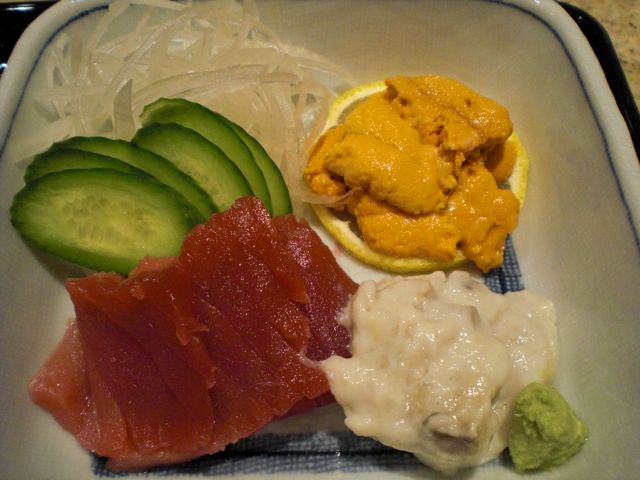 As a small grilled fish dish, I served fatty belly of salmon (harasu ハラス), simply salted and cooked in a frying pan accompanied by namasu daikon (daikon in sweet vinegar) garnished with ikura. After a few more dishes including a small hand roll of salmon skin as a shime dish, only thing we had to do was stay awake until midnight to see in the new year.
As a small grilled fish dish, I served fatty belly of salmon (harasu ハラス), simply salted and cooked in a frying pan accompanied by namasu daikon (daikon in sweet vinegar) garnished with ikura. After a few more dishes including a small hand roll of salmon skin as a shime dish, only thing we had to do was stay awake until midnight to see in the new year.

In any case, New Year's Eve has very important (added personal) significance to us. We opened a bottle of Champaign. To go with the bottle of vintaged Champaign, my opening salvo was a chawanmushi 茶碗蒸し or Japanese savory egg custard topped with California gold uni and salmon roe (ikura).
Wednesday, January 4, 2012
New Year's day feast; Osechi from Sushi Taro 寿司太郎のおせち料理重箱
We started New Year's day evening with cold chawanmushi topped with uni and ikura which was followed by a small sashimi of tuna (akami and chutoro) and uni.
 This is the second or lower box.
This is the second or lower box.
 For those who may be interested what in the boxes, the below are the links for the menu in Japanese and English.
For those who may be interested what in the boxes, the below are the links for the menu in Japanese and English.
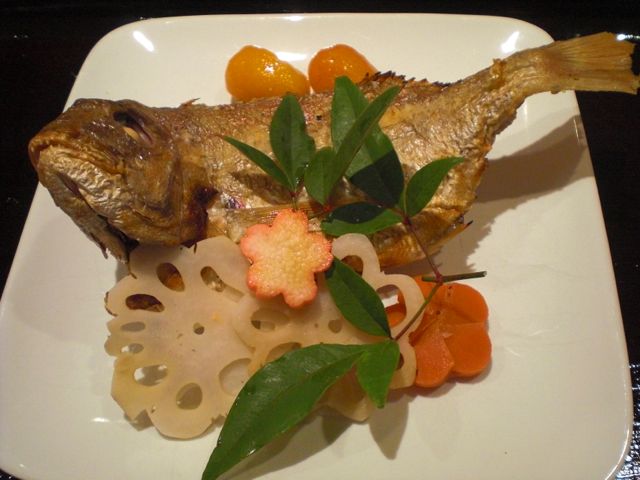 We hit the box again but still did not finish it on the 2nd day.
We hit the box again but still did not finish it on the 2nd day.
We finally started feasting on Sushi Taro's osechi juubako. The picture below is the first or upper box. It includes all the special, traditional foods eaten on New Year's day to bring good luck for the rest of the year and then some. As we started removing food we found many items hidden underneath. So the top box included several layers artfully packed one on top of the other.
Menu in English
Like kids in a candy shop we "oohhed" and "ahhed" and couldn't decide what to eat first. We tried a little of this and a little of that and ended up filling the plate shown here. But after eating this we were too full to go back for more.
 Everything was very good. Many of the items can only be made by a professional chef; for example, the monkfish liver terrine 鮟肝豆腐--which was exquisite. The fish especially the sweet fish or "ayu" with roe 子持ち鮎 was a stand out. With something like this available, I have the perfect excuse for not making Osechi myself.
Everything was very good. Many of the items can only be made by a professional chef; for example, the monkfish liver terrine 鮟肝豆腐--which was exquisite. The fish especially the sweet fish or "ayu" with roe 子持ち鮎 was a stand out. With something like this available, I have the perfect excuse for not making Osechi myself.
Like kids in a candy shop we "oohhed" and "ahhed" and couldn't decide what to eat first. We tried a little of this and a little of that and ended up filling the plate shown here. But after eating this we were too full to go back for more.
The fish pictured below was the highlight of the Jan 2nd feast from the box. This is a grilled small celebratory red fish or "tai" 鯛. After posing for the photo, he was deboned by my wife the resident deboning expert. (She claims I don't debone a fish I just take a mouthful and separate the meat from the bones in my mouth, spitting out bones and swallowing the meat.) She says she can't do that so for safety's sake she meticulously debones fish. She even recovered the cheeks from this fellow.
Monday, January 2, 2012
A Happy New Year 2012 明けましておめでとう
New Years day was very mild and quiet. After having cafe latte to wake up, we had a customary new year's soup or "ozouni" お雑煮 which is the same as any other year. Many variations of ozouni by regions and families exist. If you are interested, here is the pictures of all kinds of ozouni across Japan.
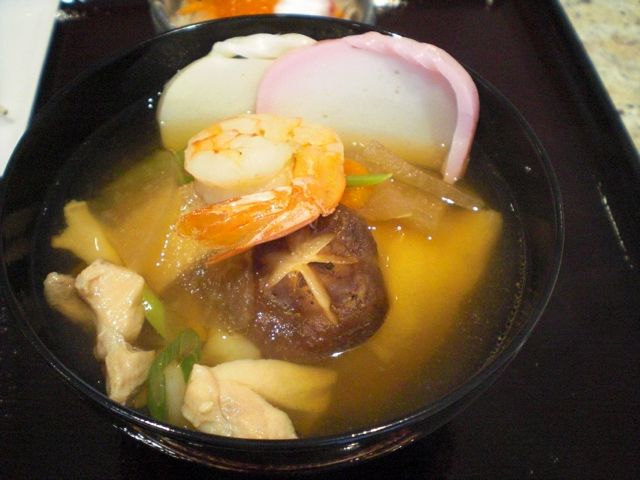
 Salmon kelp roll (left upper) and Japanese style chicken loaf with pine nuts (right upper) were specifically requested by my wife. This year, I made matsumae-zuke 松前漬け. The Japanese chicken loaf is called "pine breeze grill" or matsukaze-yaki 松風焼き.
Salmon kelp roll (left upper) and Japanese style chicken loaf with pine nuts (right upper) were specifically requested by my wife. This year, I made matsumae-zuke 松前漬け. The Japanese chicken loaf is called "pine breeze grill" or matsukaze-yaki 松風焼き.
 Matsumaezuke was made from a "kit" which contained thinly cut threads of dried kelp and squid. I added a mixture of broth (from dashi pack), soy sauce and mirin (1:1:1 ratio) and let them sit in a refrigerator overnight. I prepared herring roe or kazoko 数の子 as before. Since this was a New Year deluxe version, I cut up the kazunoko in large chunks and mixed in.
Matsumaezuke was made from a "kit" which contained thinly cut threads of dried kelp and squid. I added a mixture of broth (from dashi pack), soy sauce and mirin (1:1:1 ratio) and let them sit in a refrigerator overnight. I prepared herring roe or kazoko 数の子 as before. Since this was a New Year deluxe version, I cut up the kazunoko in large chunks and mixed in.
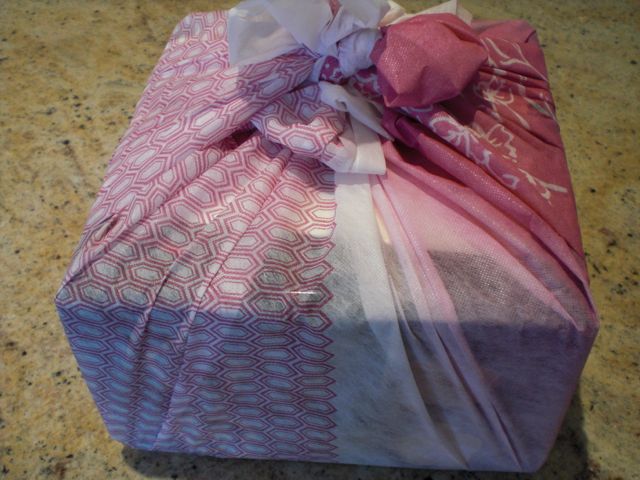 We drove to Dupont Circle on December 31 to pick it up. This is a two tired juubako wrapped in furoshiki 風呂敷, a Japanese wrapping cloth. It felt very heavy (a good sign!). According to my wife, who ran into the restaurant, while I waited outside double parked, the dining area of the restaurant had been converted to assembly area for osechi juubako.
We drove to Dupont Circle on December 31 to pick it up. This is a two tired juubako wrapped in furoshiki 風呂敷, a Japanese wrapping cloth. It felt very heavy (a good sign!). According to my wife, who ran into the restaurant, while I waited outside double parked, the dining area of the restaurant had been converted to assembly area for osechi juubako.
 After we came home, we unwrapped the furoshiki revealing the menu written in Japanese and English. Expectation heightened while we waited until New Year's day evening to fully enjoy this (come back for the next installment to see what surprises await--to be continued).
After we came home, we unwrapped the furoshiki revealing the menu written in Japanese and English. Expectation heightened while we waited until New Year's day evening to fully enjoy this (come back for the next installment to see what surprises await--to be continued).
When I've made excuses 3 years running for not making osechi おせち料理 juubako 重箱 (layered boxes, with three layers being the full implementation), nobody will believe that I used to make 3 layer boxes every year for many years. In any case, I have an excuse again this year and only made a few dishes for the new year.
For chicken Matsukaze-yaki, I cleaned and hand chopped chicken thighs into ground chicken (about 1 lb). I mixed in miso (2-3 tsp), sugar (1-2 tsp), mirin (1 tsp), flour (2-3 tsp), soy sauce (2 tsp), egg (one beaten), panko (about 1/2 cup) and mixed well (of course,you could use a food processor but I did it all by hand since I did not want to clean the bowl of the food processor). My wife helped me by dry-roasting pine nuts (3 tbs). After the pine nuts cooled down, I mixed the nuts into the meat mixture. I sprayed Pam on the metal baking dish (about 5x7 inches) and placed a parchment paper on the bottom. I then spread the mixture into the pan with a spatula to slightly less than 1/2 inch thick loaf. I baked it in a 350F preheated oven for 20-25 minutes or until the meat mixture pulled away from the sides of the pan.
After it cooled, I removed the loaf from the baking dish. Because of the Pam spray and the parchment paper, it came out without any difficulty. I first removed the all four edges (good snacking) and cut it in half dividing the short side into two long rectangles. I then cut the pieces into the shape of a Japanese "Hagoita" 羽子板 racket like you see here on the left. "Hagoita" is a racket used in a Japanese girl's New Year game called "Hanetsuki" 羽根つき which is something like badminton but the racket is made entirely of wood. Nobody plays this game and "Hagoita" has been transformed into a New Year's decorative item rather than actually being used as a racket. In any case, the shape of this dish is to imitate "hagoita". Just before serving, I inserted the toothpick in the narrowest end to further emulate the handle of the hagoita. I brushed a bit of mirin on one side and coated it with aonori 青海苔 or powdered green sea weed (see the second picture from the top). Between the pine nuts and the green color, the New Years theme "pine breeze" is complete. Pine is auspicious along with bamboo and plum flower or "shou-chiku-bai" 松竹梅 in Japanese culture especially in New Year.
But this is not the exciting part of new year's dishes. We got special osechi dishes this year from Sushi Taro 寿司太郎. This is the first year we learned that Sushi Taro makes New Year's Osechi layered boxes or Juubako, without hesitation, we signed up to get it.
Saturday, December 31, 2011
Packaged drinking snacks #2 出来合の酒のつまみ パート2
This is the last post of 2011. It will be the year of the dragon next year. Although this may not be a worthy ending of 2011, this is the second installment of the series on prepackaged drinking snacks from Japan. These three items are vacuum packed but not individually packaged. So, once you open up the bag, you have to finish them relatively quickly.
The left is miso flavored squid from Tsunami ravaged Iwate prefecture, the center is squid cheese rolls, the right is "toba" which is "cut" and "soft" accoding to the label.
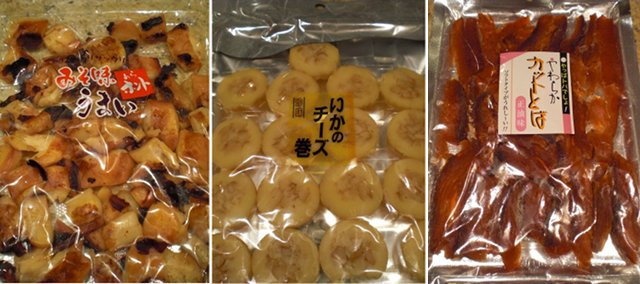
 (from left to right; smoked cheddar, toba, miso flavored squid, cheese-encased squid and cucmer slices)
(from left to right; smoked cheddar, toba, miso flavored squid, cheese-encased squid and cucmer slices)
The left is miso flavored squid from Tsunami ravaged Iwate prefecture, the center is squid cheese rolls, the right is "toba" which is "cut" and "soft" accoding to the label.
I am not sure how the squid was prepared but it is semi-dry and slightly chewy with good miso flavor. The item shown in the center picture is cut-up squid encased in mild cheese (Japanese "processed" cheese). This is rather mild and soft with a very agreeable taste. The right is "soft and cut" toba. Toba とば, written in kanji ideograms as 冬葉 which means "winter leaves". This is a famous item on my home island of Hokkaido. The name, I suppose, comes from the way the strips of salted salmon drying in the cold winter wind on the bare branches of trees resembles brown leaves. Traditonal toba is usually very chewy, or sometimes hard like a strip of leather, and very salty. It is sort of the Hokkaido version of beef jerky. This version is considerably "tamed". The skin has been removed and it is cut into smaller pieces. In addition, somehow it has been made much softer, although it is still quite salty.
I served these three items with slices of smoked sharp cheddar cheese and slices of cucumber. Somehow, these drinking snacks called for scotch and water. Although we only rarely drink hard liquor now-a-days, I made a very small and weak scotch and water. Since we had not drunk scotch for such a long time, I had to hunt around to find a bottle and eventually came up with "Chivas Regal". Somehow toba goes well with scotch. Is it possible that I used to have toba with scotch in my drinking days in Susukino 薄野?
Thursday, December 29, 2011
Packaged drinking snacks #1 出来合の酒のつまみ パート1
Like mixed nuts, mini pretzels and goldfish crackers in American bars, the Japanese have a much wider array of prepackaged drinking snacks. So, when you are in Japan, in a pinch, even in your hotel room, you could have a small party without spending a fortune on room service. Drinks (beer, whiskey, chochu, sake or premixed alcoholic drinks in a can) and drinking snacks of many different kinds are available from vending machines or near-by convenience stores (you have a better choice in the latter). We received a care package from my mother. This year, for some reason, she sent different kinds of packaged drinking snacks. The four I am showing here came in a large bag but were individually wrapped. (Such double wrapping is very common for Japanese food items).
 Here are the individually packaged items which can be stored at room temperature for quite some time. The below are what they look like after removing the wrappers.
Here are the individually packaged items which can be stored at room temperature for quite some time. The below are what they look like after removing the wrappers.
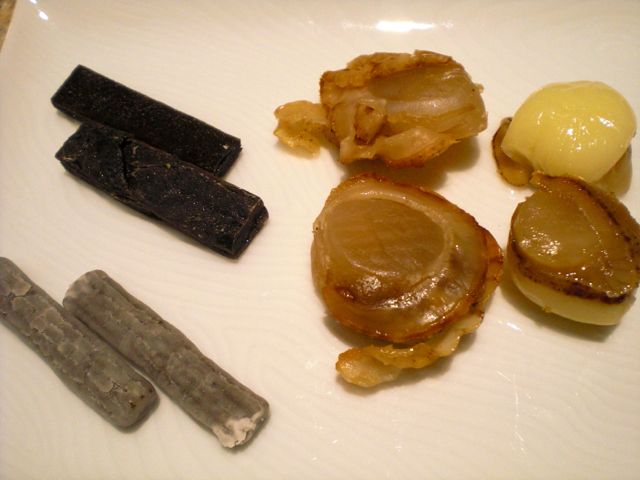 The left upper is "Iso-noki konbu" 磯の木昆布, a small layered kelp stick, which is a bit chewy but has a slight sweetness and kelp flavor (lower left in the picture below). The lower left is another kelp snack called "Yuzu-aji konbu" or yuzu-flavored kelp ゆず味昆布, a similar small kelp stick but less chewy with a nice yuzu citrus flavor (lower right in the picture below). In the center is "Iso-yaki hotate-gai" shore-grilled scallop 磯焼き帆立貝, which is a semi dried and cooked (the name implies grilled-on-the-shore) scallops. They have a nice scallop flavor but do not appear to be smoked but seasoned instead - soy sauce, mirin?? (Upper right in the picture below). Finally, on the right in the above picture is "Specail cheese hotate" スペシャル チーズ帆立, the muscle of scollop with mild cheese covering one side (Left upper in the picture below). This one is not as strongly flavored as the shore-grilled scallop.
The left upper is "Iso-noki konbu" 磯の木昆布, a small layered kelp stick, which is a bit chewy but has a slight sweetness and kelp flavor (lower left in the picture below). The lower left is another kelp snack called "Yuzu-aji konbu" or yuzu-flavored kelp ゆず味昆布, a similar small kelp stick but less chewy with a nice yuzu citrus flavor (lower right in the picture below). In the center is "Iso-yaki hotate-gai" shore-grilled scallop 磯焼き帆立貝, which is a semi dried and cooked (the name implies grilled-on-the-shore) scallops. They have a nice scallop flavor but do not appear to be smoked but seasoned instead - soy sauce, mirin?? (Upper right in the picture below). Finally, on the right in the above picture is "Specail cheese hotate" スペシャル チーズ帆立, the muscle of scollop with mild cheese covering one side (Left upper in the picture below). This one is not as strongly flavored as the shore-grilled scallop.
 These snacks are much more interesting and tasty (and sometimes chewy) than their American counterparts. It is very convenient as a drinking snack while you are making something else for your drink. My wife liked the yu-zu flavored kelp stick the best followed by the cheese covered scallop. I was more partial to the two scallop snacks. Whichever snacks we preferred, we both ended up drinking quantities of water--because although individually they are pleasingly seasoned cumulatively we felt we had eaten a lot of salt.
These snacks are much more interesting and tasty (and sometimes chewy) than their American counterparts. It is very convenient as a drinking snack while you are making something else for your drink. My wife liked the yu-zu flavored kelp stick the best followed by the cheese covered scallop. I was more partial to the two scallop snacks. Whichever snacks we preferred, we both ended up drinking quantities of water--because although individually they are pleasingly seasoned cumulatively we felt we had eaten a lot of salt.
Tuesday, December 27, 2011
Omelet rice オムライス
One evening, this was what we had as a shime 〆 or ending dish. I thought about what we had in the fridge and suggested to my wife "chicken omelet rice" or "omuraisu" オムライス. Omuraisu, "omu" is short for "omelet" and "raisu" i.e. rice in Japanese. It is a quintessential Japanese style Western "Yoshoku" 洋食 dish and also one "kids" like. I am not sure about the history of omuraisu but the movie "Tampopo" たんぽぽ made a version of omuraisu famous. Please see this link for the details and the actual movie footage.
The basic omurice is fried rice flavored with ketchup and covered with an omelet. I do remember my mother making it for us when we were kids. She had a special rice mold just for omurice.
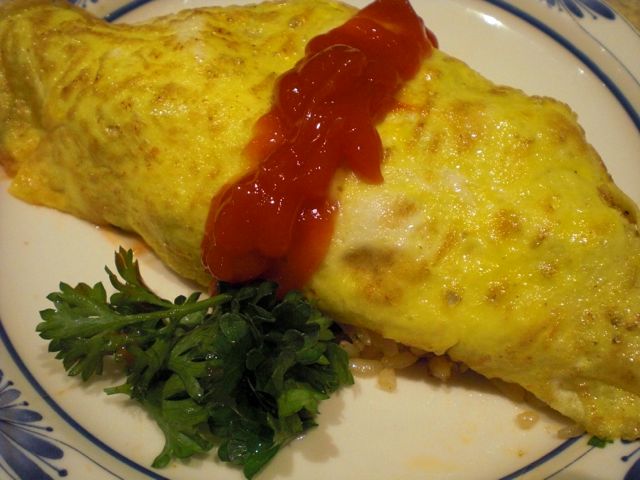 You cannot really appreciate the size of this omurice seen above but this is a miniature version and probably less than 1/3 of the usual size. As such it is a perfect shime or ending dish for us.
You cannot really appreciate the size of this omurice seen above but this is a miniature version and probably less than 1/3 of the usual size. As such it is a perfect shime or ending dish for us.
Rice: As ususal I used previously frozen rice (about 1/2 cup) which was briefly microwaved; not warm but the grains could be separated (in my case about 30-40 seconds).
I used finely chopped shallot (1 medium or onion), leftover barbecued chicken (meat from one leg, cut into small cubes), and parsley (several sprigs, finely chopped). The more authentic recipe calls for canned green peas for greenery.
I added light olive oil (1 tbs) to a non-stick frying pan on medium heat. I first sautéed the shallot for 1 minute or until it became semi transparent, I then added the chicken meat and the rice and fried them for 1-2 minutes. I seasoned it with salt and pepper. I then moved the rice mixture to one side making an empty area in the frying pan. I added about 2 tbs of ketchup and stirred using a silicon spatula without mixing it with the rice for 1 minutes until the color darkened (which makes the flavor of ketchup a bit more complex). I then mixed the ketchup with the rice mixture and added the parsley. I tasted (adjust the seasonings if needed) but did not need more seasonings.
After I divided the fried rice into two portions, I cleaned the frying pan and added a pat of butter and one egg (beaten) to make a thin omelet. I devided the omelet in half and draped it over the mound of rice and adjusted the shape to make it presentable. I squirted the ketchup on the top and added parsely springs as a garnish. If you have, you could erect a small Japanese flag or any national flag of your choice on the omuraisu but that is for kids. I have no idea why a flag is used to decorate a "lunch" for kids or "Okosama ranchi" お子様ランチ in which "omuraisu" is one of the most popular items.
My wife is not crazy about "ketchup" flavored rice but I think this is a perfectly fine dish for adults to end the evening as long as you do not erect a national flag on it.
Sunday, December 25, 2011
Edible chrysanthemum with black sesame sauce 春菊の黒ごま和え
Edible chrysanthemum or "shungiku" 春菊 is one of my wife's favorite Japanese vegetables. We even grew some from the seeds for few years. The harvest, however was was quite meager and the plants frequently got leggy consisting mostly of stalks with few leaves so we stopped growing it. Only sporadically, do I see fresh shungiku at the Japanese grocery store. This green is usually used in "Sukiyaki". My wife, however, gets quite creative with it, claiming that "shungiku in not just for sukiyaki any more." She shocked several of my Japanese friends by using it as lettuce in a salad..."but it is never eaten this way in Japan", they exclaimed. My wife asked, "why not?"
 Shungiku: This started out as a good sized bunch but once cooked, like spinach, it reduced tremendously. I first cut off the largest stalks on the bottom and blanched the bunch in salted boiling water for about 1 minute and immediately shocked it in ice water. Using paper towels, I wrapped the shungiku and squeezed out any excess moisture as much as I could. I then wrapped the shungiku in nori sheet to make a cylindar. I sliced the cylindar into 4 pieces (2 pieces per serving as you can see above).
Shungiku: This started out as a good sized bunch but once cooked, like spinach, it reduced tremendously. I first cut off the largest stalks on the bottom and blanched the bunch in salted boiling water for about 1 minute and immediately shocked it in ice water. Using paper towels, I wrapped the shungiku and squeezed out any excess moisture as much as I could. I then wrapped the shungiku in nori sheet to make a cylindar. I sliced the cylindar into 4 pieces (2 pieces per serving as you can see above).
I bought shungiku last weekend but did not have a chance to prepare it. Rather than let them go waste, I decided to make this simple dish.
Black sesame sauce: This is exactly as I posted before. I used black sesame paste from the pouch (2 tbs), sugar (1 tsp), soy sauce (1-2 tbs), if needed, sake or mirin to adjust the consistency.
The flavor of shungiku is very unique. It is not spinach and really taste like "chrysanthemum". This is rather healthy but quick good dish. Next time, when I get fresh shungiku, I have to make sukiyaki--unless my wife comes up with something else first.
Subscribe to:
Comments (Atom)

